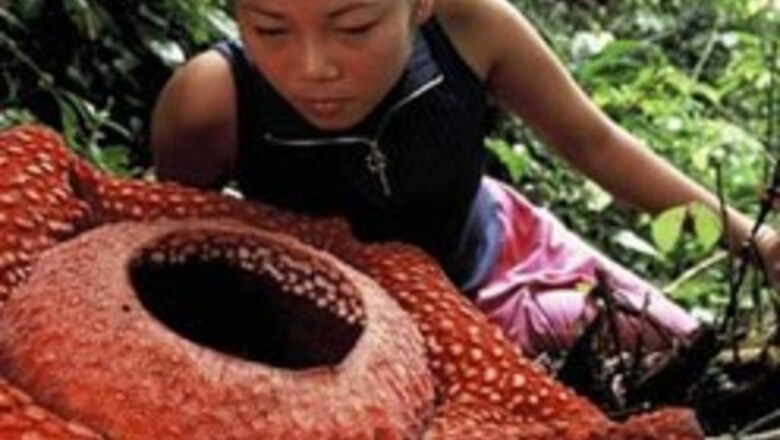
views
Washington: It is the world's biggest flower, and maybe the stinkiest, too. And now scientists have used genetic analysis to solve the long-standing mystery of the lineage of the rafflesia flower, known for its blood-red bloom measuring three feet (1 meter) wide and its nauseating stench of rotting flesh.
Writing in the journal Science on Thursday, a team of researchers said rafflesia -- discovered in an 1818 scientific expedition to a Sumatran rain forest, comes from an ancient family of plants known not for big flowers, but for tiny ones.
In fact, many of its botanical cousins boast flowers just a few millimeters wide.
This family, called Euphorbiaceae, also includes the poinsettia, Irish bells and crops such as the rubber tree, castor oil plant and cassava shrub, the researchers said.
Rafflesia's many odd characteristics long had tripped up scientists trying to figure out where it fit on the botanical tree of life.
It is sort of a botanical outlaw - a parasitic plant that steals nutrients from another plant while deceiving insects into pollinating it.
"They really are a funky plant," Harvard University plant biologist Charles Davis, who led the research, said.
Rafflesia (pronounced rah-fleez-ee-ah) lives inside the tissue of a tropical vine related to the grapevine, with only its flower visible.
It is devoid of leaves, shoots and roots, and does not engage in photosynthesis, the process plants use to exploit the energy from sunlight.
Its flowers can weigh 15 pounds (seven kg). They are a blotchy blood red. They smell like decaying flesh.
And they even can emit heat, perhaps mimicking a newly killed animal in order to entice the carrion flies that pollinate it.
’Totally fetid’
"They really do look and smell like rotting flesh. They are a totally fetid, stinking, foul kind of flower. It can be totally repulsive to so many of us. But to the flies that visit these things, it's just delightful," Davis said.
PAGE_BREAK
There are various species of rafflesia growing on the floor of rain forests in parts of Southeast Asia, with Borneo the center of its diversity, Davis said.
Davis said its lineage dates back roughly 100 million years to the Cretaceous Period, the last act of the Age of Dinosaurs when flowering plants are believed to have first appeared. The researchers determined that over a span of 46 million years, rafflesia's flowers evolved a 79-fold increase in size before assuming a slower evolutionary pace.
Recent efforts to nail down plant lineages have relied on molecular markers in genes relating to photosynthesis, but that was not possible with rafflesia. The researchers had to scour other parts of its genome for clues.
"These plants are so bizarre that no matter where you put them with any group of plants, you're going to have a lot of explaining to do," Davis said. "But what was surprising was that with all of the options available as close relatives, they are nested within this group of plants with absolutely tiny flowers."
Southern Illinois University plant biologist Daniel Nickrent, who took part in the research, said this deeper understanding of rafflesia might aid people keen to develop larger flowers and fruits.
It was discovered on an expedition led by Sir Thomas Stamford Raffles, who founded the British colony of Singapore, and naturalist Joseph Arnold, who died of malaria on the trip.

















Comments
0 comment